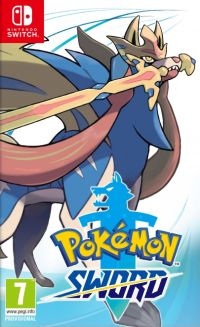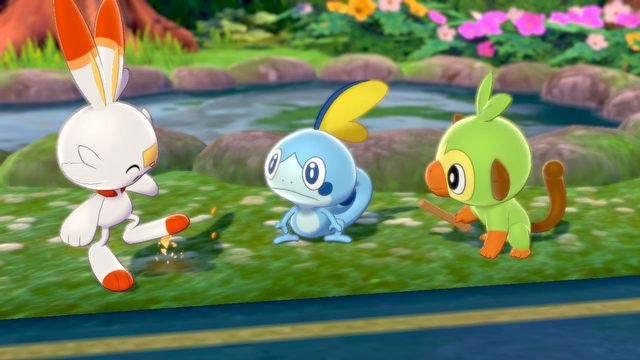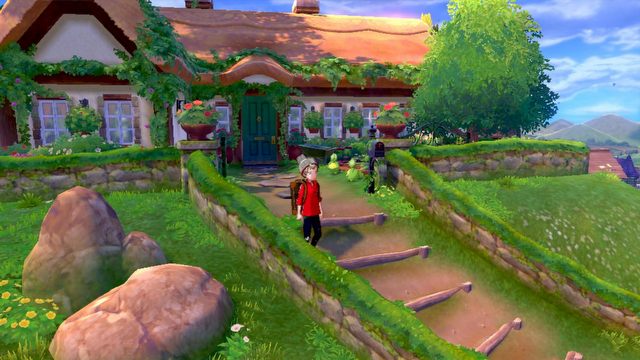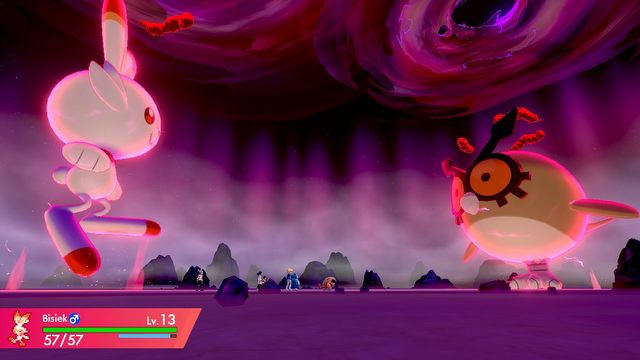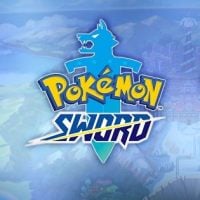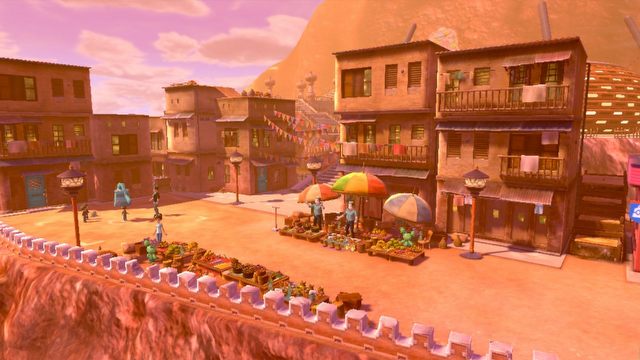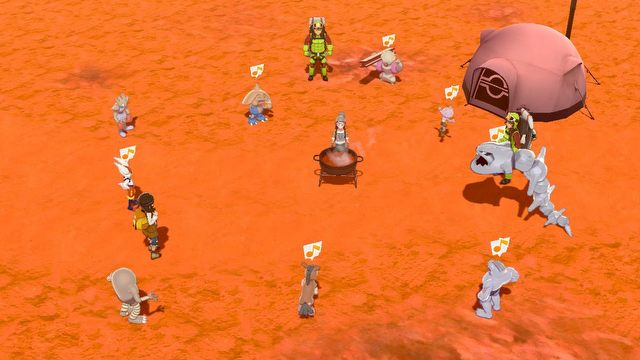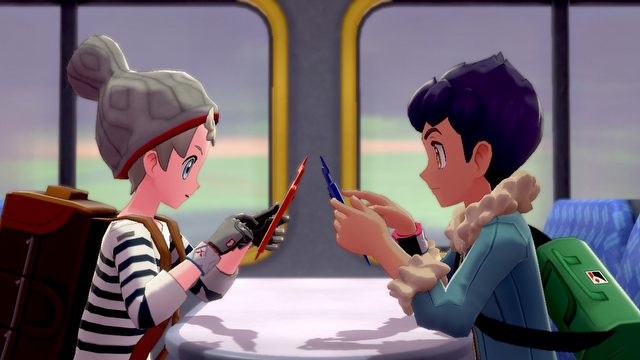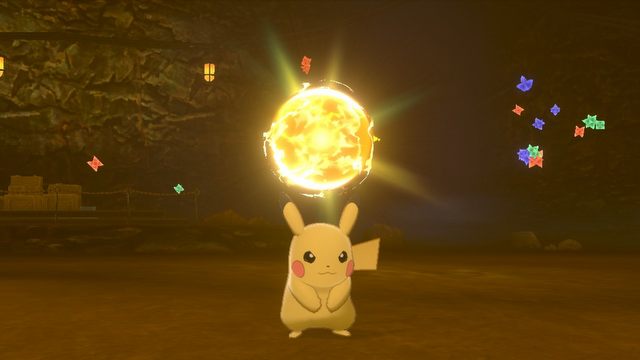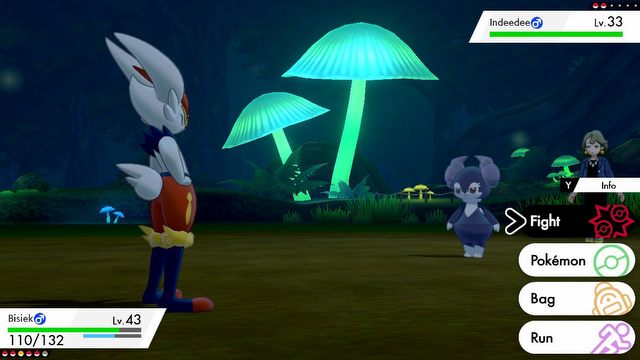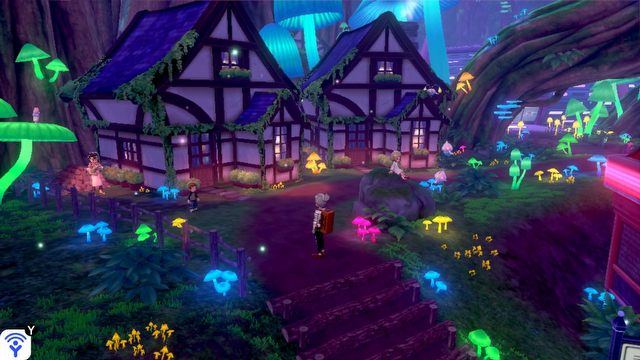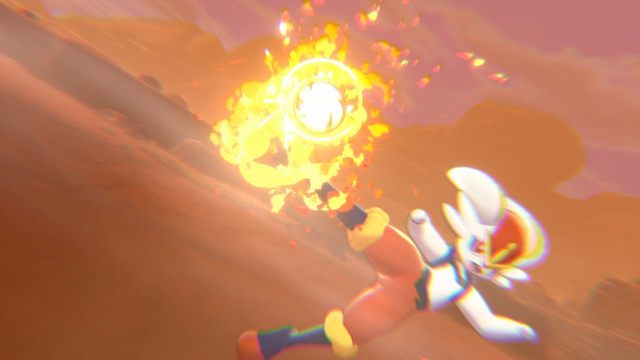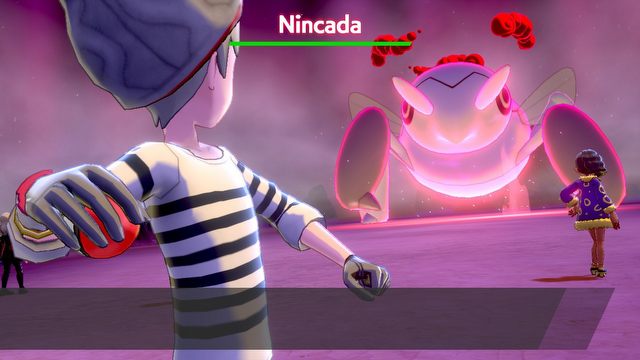Pokemon Sword Review – It's not very Effective!
Pokemon Sword and Shield are extremely secure investments – we get what we got 23 years ago, but in a new graphic design. And although the series remains amusing and enchanting, you can't deny that rotten wood is gaping from underneath the colorful paint.
The review is based on the Switch version.

- beautiful, colorful, fully three-dimensional graphics;
- well-made Pokémon models;
- spectacular, explosive combat;
- Pokémon Gyms finally feel like real fights for championship;
- beautiful atmosphere of locations, which really invite exploration;
- accessible to younger, new players.
- probably the easiest Pokémon you've played;
- annoying soundtrack;
- modern graphics can't conceal obsolete mechanics;
- untapped potential of Dynamax;
- the plot is simplistic and naive – even for a Pokémon game.
I've been playing Pokémon games from Game Freak studio for 23 years. Now, can you believe that in the last part – Pokémon Sword (and Pokémon Shield) is still using mechanics that were used in Pokémon Red and Blue back in the 90s. If you want to go back to those charming childhood years, the newest Pokémon is the perfect way to do this. In terms of technology and accessibility, this is the best about the belligerent creatures, although, in some respects, the new approach of Game Freak can be defined by the well-known phrase: "It's not very effective..."
I shall not ponder over the question of what Pokémon actually is, because I dare to assume that the series has fossilized so much throughout the years that it's become an inseparable part of the gaming DNA. For those who have never heard of the Pokémon, I hasten to explain: this is a story about young heroes, who leave their hometown to become Pokémon champions. During the expedition, we catch monsters, train them, and pit them against each other in a turn-based, classic RPG system. Once they've collected 8 badges, they can approach the final duel. And this hasn't changed for 23 years.
The most beautiful Pokémon
A few years ago, when I beat Pokémon Pearl, I raised my hands to the heavens, letting out a cry: "How dare they?!" How can anyone have the audacity to create something that looks like it was put together in RPG Maker – in the heyday of beautiful, 3D RPGs? My voice apparently echoed across continents and oceans, because now we ended up with a game that maybe isn't cutting-edge, but it's at least modern.
The old, if not archaic, gameplay known for decades, finally received a beautiful, vivid, and fully three-dimensional visual envelope. Villages, cities, mines, caves or forests finally look like what you'd expect from a magical and strange world inhabited by the Pokémon. No more fighting with pixelated bitmaps. The creature and human models are well crafted – overall, combat in this installment is no longer a thing that mostly happens in the player's imagination. Instead, there will be explosions, lasers, raging elements, earthquakes, and so on, all furnished with different animations. And while some things could use more polishing (some of the attacks are generic and used by many beasts, and it's hard not to feel that some of them have been neglected), the overall impressions are solid nonetheless. With the revamped graphics, combat has become spectacular and full of explosions, almost like in Michael Bay's.
Why not six?
Taking the right approach to this review was tricky – Game Freaks' latest work is a tough nut. If the score 7.5 seems surprising after reading my rants – in the text, I complain and mercilessly indicate numerous issues – allow me to explain: if you were to rate what Pokémon Sword did – this game deserves a decent 7.5. If you think about things that could have been done, but were not, things will become more complicated. Considering that everyone knows what the gaming Pokémon is, instead of redundant explanations, I decided to evaluate – apart from the game itself – the things we might be missing, looking forward to, and that this series simply needs.
However, the most important part of this small but long-awaited "revolution" are the locations. Just take a look at some of the initial spots, such as the rustic Postwick, or Ballonlea, full of glowing mushrooms, and you should understand this is exactly what the series has been missing for years – a consistent and apt depiction of that weird world. The capital of the Galar region, the city of Wyndon, is really a fairy-tale London, with the Thames, the Big Ben, the Eye of London, the Trafalgar square and Piccadilly Circus, with red telephone booths and the tube. And even if there's not many activities in these regions, just walking around and taking it in can be entertaining.
Little adventures and big Pokémon
The new work from Game Freaks quickly introduces us to several key novelties. They all look quite impressive, but not all of them are useful. The main ingredient of both the world and the plot, as well as the mechanics, is the Dynamax transformation. In essence, the transformation allows the Pokémon to expand to truly huge sizes in the right circumstances (or rather: the right places). With this mechanics, the cute Pikachu becomes a hundred-foot giant that wreaks havoc on the battlefield.
In practice, Dynamax is used only in battles with bosses (i.e. Pokémon Gym's head coaches) and in certain places on the single, sandbox map (which is another novelty). And although it all looks very impressive, the animations are beautiful, and the attacks carry a nice punch to them, it's hard to shake off the feeling that this is just a time-consuming and rather superfluous addition. I've defeated the big Pokémon many times with a single hit without even bothering with the transformation. This actually is a more serious problem, which I will address in detail further in the text. For now, bear in mind that Dynamax seems an interesting, but untapped idea for enriching the duels between the Pokémon.
In fact, every solution featured in Pokémon Sword is at least two-decades old. We have a hero with whom we venture into the world. Our opponents, as usual, are cool and overconfident. There are Pokémon Gyms, where we can fight with others, and the infamous Team Rocket is replaced by some harmless morons from the Yell Team. Really – if you've just played Pokémon Red 23 years ago, you will quickly recognize most of the elements used in Pokémon Sword.
The writing on the wall here is obviously the question whether recycled ideas from two decades ago are enough to make for a riveting experience. Unfortunately, what I felt the most when playing Pokémon Sword was weariness. I always knew what was the next thing that was going to happen, what the next "surprise" it was brewing would be. And admittedly, I felt pretty much the same thing when playing Pokémon Platinum, Pearl, Black or Emerald. This is a strange feeling, where the initially pleasant melancholy is subsided with the realization that there's no going back to your childhood. And so, the creators of Sword and Shield are ultimately the victims of their own strategy – trying to recreate the same world we remember from before decades, they seem to have forgotten the world has moved on.
Also note that this does not necessarily have to be a disadvantage, and that weariness can also be interpreted as a sort of safety. Maybe there are people among us who expect exactly this – the past served in a modern dressing. And nothing beyond.
Flaws of a beautiful world
The first impression is excellent. The game establishes some simple storyline, which is more like Zelda (the impeding end of the world), and then we just set out to the world to catch them all. The combat system we've known for years is digestible like no other in the history of games – the simplicity of the turn-based, j-RPG battles has been known since the 80s – various developers are either trying to rephrase it or, conversely, get away from it (like Square-Enix in Final Fantasy) – and meanwhile, Game Freak delivers an absolutely classic system taken straight from their older games. We issue orders, exchange attacks and the one who dies is the one who either has significantly smaller level of experience, or the one, who has chosen the wrong monster (fire beats grass, water beats fire and so on).
Players know, and generally enjoy this system – if you're sure this is up your alley, then you needn't bother reading the rest of the review – this is exactly the same Pokémon you've been playing for years. However, if you feel that spending sixty bucks on this thing seems like a stretch considering lack of novelties, then you might want to stick around and hear what this game's missing.

SECOND OPINION
The whole "Dexit" thing aside (no Squirtle and Psyduck, seriously?) the new Pokémon game is simply disappointing! The characters are dumb, the plot is formulaic as never before, the game is at times childishly simple, the open world is not particularly interesting, and Dynamax proves so groundbreaking that we might just as well not hear about it ever again. The raids do have some potential, and the framework can still provide great fun and even become addictive, but as a fan of the series since the first full-fledged installment on the Switch, I expected a lot more. My score: 6/10
Jordan
To be honest, I'm not particularly fond of some of the new Pokémon designs – my loyalty lies with the old stunners such as Bulbasaur, Squirtle, or Charmander (of that iconic trio, you'll only find Charmander in the latest Pokémon – and only after finishing the game). So, I also missed Psyduck or Abra, but to be perfectly honest, if you are fanatics, you will soon get over these absences. Even though I will not join those critics that claim there's too few monsters to catch – for me, 400 is a hefty number that makes the "catch 'em all" slogan seem a major exaggeration, it's easy to predict that many players would like to see the most famous creatures.
There's no Psyduck or Jigglypuff, some of the Pokémon that have been the icons of the franchise for decades! Instead, we will encounter many creatures of, let's call it, controversial design. I can swallow Rolycoly (flying carbon) or Yampera (an electric dog), but could we do away without, say, Bronzor or Klink to make some room for the aforementioned, great absentees?
Even children won't buy this story
I mentioned meager plot. The stories in Pokémon were never very fascinating – after all, they were always addressed to kids, telling of a world with amiable creatures, which people use for violent, bloody arena duels (wait, what?).
Honestly, the story seemed so boring I stopped paying attention after getting the second badge. The titular legendary Pokémons of Sword and Shield are so unimportant to the game itself that you probably won't bother catching them until after the end credits.
The NPCs never care to hide they're onto something, nor that their motivations don't make any sense. The main, hidden "villain" has an idea idiotic enough that not even children will buy it. In all this galaxy of casual conversations and skipping dialogue lines, only Leo – the typical champion – stands out as a more interesting character. Why couldn't they write something that would be at least pretending not to be infantile? Meanwhile, the surprises offered by the story in Pokémon Sword are a humbug without any solid foundations. These are placeholders or – as fans of animé would have it – unassuming fillers.
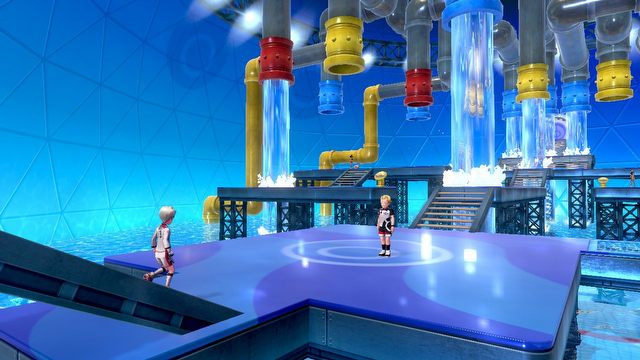
Before every battle for a Pokemon badge, we must carry out some missions. Pokemon Gyms have been well designed.
These beautifully designed cities gape with emptiness – the only reason to visit them is winning at the local stadium and curing our Pokémon. Side quests are few and far between, and that's really not good – if executed properly, they could really enliven the locations, encouraging exploration. This assertion came to me when I accidentally bumped into a little girl in some city, who asked me to deliver her love letter to a boy living in another town. When I found the chap, it turned out he was no longer a boy, but an old man. He told me the story of his childhood friend, who went terribly ill. When he asked me if she was alright, I could lie and answer in the affirmative. The girl turned out to have been a ghost. Surprising? Curious? Certainly better than "if you have the Pokémon X, then we can trade it off for a Y!"
These activities aren't abundant, and unless you decide to pay up extra for network services (the multiplayer module Pokémon Sword is required for basically everything that has to do with interacting with other players), you will quickly stop visiting cities for a different purpose than pushing the plot forward. Too bad!
I'm a Pokémon master
To create a game accessible and simple, at the same time avoiding falling into banality – that's a challenge. Completing Pokémon Sword took me 24 hours. I didn't die once. My whole team was never defeated, and I came really close to a defeat maybe two, or three times. During the game, the player is not short on anything – money, items, first aid, Poke Balls – it's all there, in abundance. There's almost no risk to combat, so we approach most battles head-on.
Imagine – you're a young, novice Pokémon trainer, you come to a city with a large arena, and you have to defeat its long-standing champion. He throws everything he's got at you – his best monsters, battle-hardened over the years, and you just whoop his ass with a single Pokémon you've received in the first ten minutes of the game.
I've defeated almost all the bosses of this game with a single attack – even including those that theoretically had the elemental advantage over me. My starter was Scorbunny (fire). Why, then, was I able to walk all over the stone and water masters as if they weren't even there? Throughout the game, I only had any trouble with the fairy master, and some of the last battles. Well, at least the end-game is solid – including some genuinely challenging fights – but it's only after the end of the game, so how many people do you expect to reach them?
Such low level of difficulty is no longer about accessibility – it's simply unsatisfactory. When my Scorbunny turned into a Raboot and then into Cinderace, any strategy went out the window. I would just spam Pyro Ball attacks, sending all enemies to hell – invariably, and without any effort.
Strength in numbers
Good and bad decisions were made during the production of the newest Pokémon. High-quality graphics and animations, getting rid of the annoying HMs, giving experience even to the Pokémon that didn't take part in combat, or designing impressive arenas and fights are certainly welcome changes. Wild Pokémon now roam the fields, we can choose our opponents ourselves, and the giant creatures are quite impressive. At last!
At the same time, the rudimentary plot is rather demotivating, as is the difficulty level, or the emptiness of the locations. And that's too bad, because the potential of this world – as proven by the multiplayer module, diligently supported for many years – is great. The fact that the hyped raids are actually simple 4v1 fights, and nothing else, isn't that bad. The real problem is that these elements is one of the few things that diversify this world. The direction seems to be right, but how many installments will it take before we get a real revolution?
Pokémon Sword remains a good game, but at the same time it's practically begging for changes in numerous areas. Maybe these trivial fights are not just a matter of the level of difficulty? Maybe it's time for a major overhaul and reconstruction, which will introduce a little more tactics in the series than "water extinguishes fire"? Or maybe it's time to introduce a choice of difficulty – just like that?
This is a pretty old series. I am sure that once I've lived my life in this realm of tears, new generations will still be playing Pokémon games. And I wouldn't be surprised if those weren't substantively different from what we've got here. Because Pokémon is an extremely safe investment that consistently generates millions of dollars.
Again – too bad – because nostalgia and melancholy are one thing, and archaism is something completely different, and much more problematic. Even if this archaism is served in such a beautiful way as it is in Pokémon Sword. If you've played any of the previous Pokémon, you should be able to have a good time catching and training the monsters for hours on end. But during the game, you might also feel the creators are constantly selling you the same thing. Maybe it's time for experimentation and bold decisions – these Pokémon are too slow to evolve.
ABOUT THE AUTHOR
I finished Pokémon Sword in 24 hours. This time was pleasant, but not astonishing. I've played many Pokémon games in my life, including Red/Blue, Yellow, Black, Platinum and so on. I am not, however, the biggest fan of the universe – I was already a bit too old for the TV anime when it first came out. Still, I sometimes revisit the series – maybe for curiosity, maybe for nostalgia.
DISCLAIMER
We received a review copy of the game from ConQuest Entertainment – much appreciated!
Pokemon Sword
Pokemon Sword Review – It's not very Effective!
Pokemon Sword and Shield are extremely secure investments – we get what we got 23 years ago, but in a new graphic design. And although the series remains amusing and enchanting, you can't deny that rotten wood is gaping from underneath the colorful paint.
